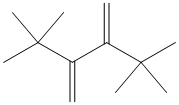
ORGANIC CHEMISTRY-W/STUD.SOLN.MAN.
10th Edition
ISBN: 9781260001099
Author: Carey
Publisher: MCG
expand_more
expand_more
format_list_bulleted
Concept explainers
Textbook Question
Chapter 11.12, Problem 19P

Expert Solution & Answer
Want to see the full answer?
Check out a sample textbook solution
Students have asked these similar questions
PLEASE ANSWER BOTH i) and ii) !!!!
E17E.2(a) The following mechanism has been proposed for the decomposition
of ozone in the atmosphere:
03 → 0₂+0
k₁
O₁₂+0 → 03
K
→>
2
k₁
Show that if the third step is rate limiting, then the rate law for the
decomposition of O3 is second-order in O3 and of order −1 in O̟.
10.
Chapter 11 Solutions
ORGANIC CHEMISTRY-W/STUD.SOLN.MAN.
Ch. 11.1 - Prob. 1PCh. 11.1 - Prob. 2PCh. 11.2 - The two compounds shown differ by a factor of 60...Ch. 11.2 - Prob. 4PCh. 11.2 - Prob. 5PCh. 11.2 - Prob. 6PCh. 11.3 - Prob. 7PCh. 11.3 - Prob. 8PCh. 11.3 - Evaluate 2,3,3-trimethyl-1-butene as a candidate...Ch. 11.4 - After heating a solution of allyl tert-butyl...
Ch. 11.5 - Prob. 11PCh. 11.6 - Prob. 12PCh. 11.8 - Prob. 13PCh. 11.9 - What dienes containing isolated double bonds are...Ch. 11.10 - Prob. 15PCh. 11.10 - Prob. 16PCh. 11.11 - Prob. 17PCh. 11.12 - Dicarbonyl compounds such as quinones are reactive...Ch. 11.12 - 2,3-Di-tert-butyl-1,3-butadiene is extremely...Ch. 11.12 - Methyl acrylate (H2C=CHCO2CH3) reacts with...Ch. 11.13 - Prob. 21PCh. 11.14 - What diene and dienophile could you use to prepare...Ch. 11.14 - Write equations in the synthetic direction for the...Ch. 11.16 - Prob. 24PCh. 11.16 - Prob. 25PCh. 11 - Write structural formulas for each of the...Ch. 11 - Give an acceptable IUPAC name for each of the...Ch. 11 - A certain species of grasshopper secretes an...Ch. 11 - Which of the following are chiral?...Ch. 11 - Describe the molecular geometry expected for...Ch. 11 - Prob. 31PCh. 11 - What compound of molecular formula C6H10 gives...Ch. 11 - Prob. 33PCh. 11 - Prob. 34PCh. 11 - Prob. 35PCh. 11 - Prob. 36PCh. 11 - Identify the more reactive dienophile in each of...Ch. 11 - Prob. 38PCh. 11 - Prob. 39PCh. 11 - Prob. 40PCh. 11 - Prob. 41PCh. 11 - Prob. 42PCh. 11 - Prob. 43PCh. 11 - Prob. 44PCh. 11 - Prob. 45PCh. 11 - Prob. 46PCh. 11 - Show how to prepare each of the following...Ch. 11 - Prob. 48PCh. 11 - Prob. 49PCh. 11 - Prob. 50PCh. 11 - Compound A was converted to compound B by the...Ch. 11 - Suggest reasonable explanations for each of the...Ch. 11 - Prob. 53PCh. 11 - Prob. 54PCh. 11 - Prob. 55DSPCh. 11 - Prob. 56DSPCh. 11 - Prob. 57DSPCh. 11 - Prob. 58DSPCh. 11 - Prob. 59DSP
Knowledge Booster
Learn more about
Need a deep-dive on the concept behind this application? Look no further. Learn more about this topic, chemistry and related others by exploring similar questions and additional content below.Similar questions
- Can someone draw a reaction mechanism of this reaction please I was told that the boc l alanine is deprotonated first and acts as the nucleophile attacking the EDCL and can you please show all the intermediates and side products and the water at the endarrow_forwardX- 22.5 d 33.0 d P17E.3 Two radioactive nuclides decay by successive first-order processes: → Y → Z (the quantities over the arrows are the half-lives in days). Suppose that Y is an isotope that is required for medical applications. At what time after X is first formed will Y be most abundant?arrow_forwardUse solubility rules to complete balance molecular equations, and provide total and net ionic equations. Silver Nitrate and Iron(III) Nitrate Copper(II) Sulfate and Ammonium Chloride Copper(II) Sulfate and Magnesium Chloride NH₄Cl(aq) + MgCl₂(aq) → NH₄Cl(aq) + Fe(NO₃)₃(aq) → NH₄Cl(aq) + BaCl₂(aq) →arrow_forward
arrow_back_ios
SEE MORE QUESTIONS
arrow_forward_ios
Recommended textbooks for you

 Organic ChemistryChemistryISBN:9781305580350Author:William H. Brown, Brent L. Iverson, Eric Anslyn, Christopher S. FootePublisher:Cengage Learning
Organic ChemistryChemistryISBN:9781305580350Author:William H. Brown, Brent L. Iverson, Eric Anslyn, Christopher S. FootePublisher:Cengage Learning


Organic Chemistry
Chemistry
ISBN:9781305580350
Author:William H. Brown, Brent L. Iverson, Eric Anslyn, Christopher S. Foote
Publisher:Cengage Learning
Coenzymes and cofactors; Author: CH15 SWAYAM Prabha IIT Madras;https://www.youtube.com/watch?v=bubY2Nm7hVM;License: Standard YouTube License, CC-BY
Aromaticity and Huckel's Rule; Author: Professor Dave Explains;https://www.youtube.com/watch?v=7-BguH4_WBQ;License: Standard Youtube License